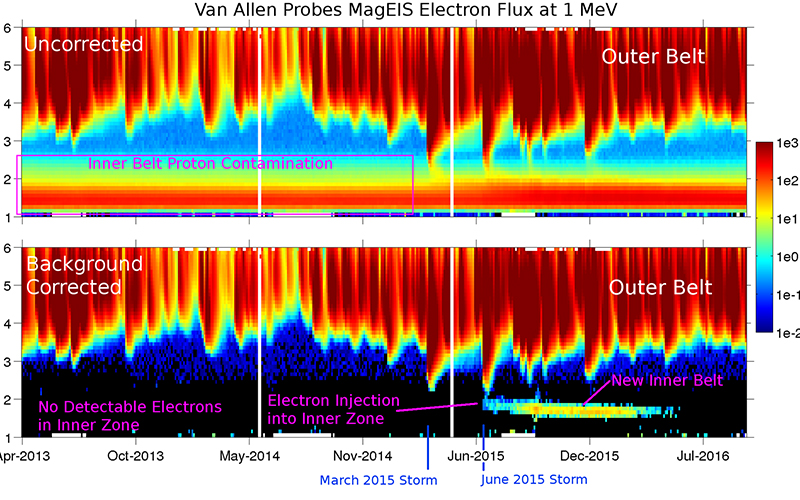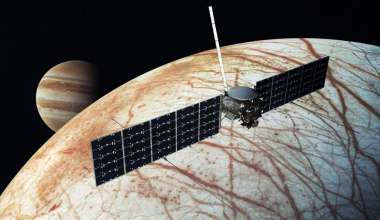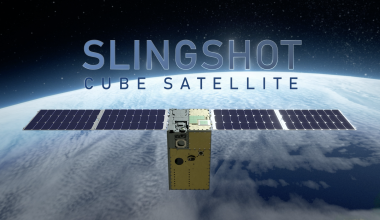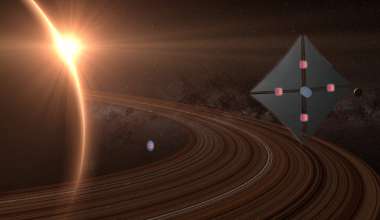It was previously believed that there was a dynamic outer electron belt surrounding Earth, with an inner belt dominated by protons with a lower-energy, yet stable, electron component. These belts are separated by a slot region that is devoid of particles. While scientists have known for some time that the slot region can fill with electrons, the true nature of inner belt electrons has a strikingly different character than what was previously believed. The findings now show that at times, the inner belt is devoid of high-energy electrons, such that there is only an outer electron belt at high energy.

However, following strong geomagnetic storms, a new, transient population of high-energy electrons can form in the inner belt. It can take months or even years for this new belt to die away. Until now, these inner belt dynamics had been hidden from view due to the inner belt protons causing misleading sensor readings.
A Custom Sensor To Measure The Inner Radiation Belt
These findings are exciting because scientists can now observe and measure the inner belt with confidence, which was not possible before the Van Allen Probes. “Scientists have been waiting nearly a quarter century to fly this specially designed sensor in this orbit. We are now seeing these hidden inner zone electrons, and it’s very exciting,” said Dr. Seth Claudepierre, Space Sciences Department. He has led this effort with Aerospace colleagues Drs. Bernard Blake, Joseph Fennell, and Paul O’Brien. Results of the team’s research were published in the March 2017 issue of the Journal of Geophysical Research — Space Physics.
The results are important for spacecraft engineering and design going forward because they suggest that current design models may be overestimating the intensity of high-energy electrons in the inner belt, thus overestimating the deleterious electron radiation that spacecraft must contend with in low and medium altitude orbits. This has resulted in heavier and more expensive spacecraft than may have been necessary.
Advent Of New Space Radiation Models
In addition to advancing scientific knowledge, Aerospace scientists will use data from the Van Allen Probes to develop new space radiation environment models for satellite design and studies. While Aerospace-designed space radiation models have been industry benchmarks for several decades, they output an estimate of the average energetic-particle flux and do not provide information on the natural variability of the environment. The current practice is to apply arbitrary rules-of-thumb to account for uncertainties in environmental models and system impacts.
For example, the total dose specification is often chosen to be a prediction of the average environment multiplied by a factor of two. The more recent radiation models output a detailed statistical estimate, eliminating the need for the arbitrary factor of two, but additional radiation measurements are needed for the models to achieve their full capability and give spacecraft designers the accuracy they need to design long-lived space assets without unnecessary and costly overdesign.

The Magnetic Electron Ion Spectrometer And Relativistic Proton Spectrometer
Building on decades of experience in the design and construction of spaceborne instruments, Aerospace scientists conceived, designed, and built two unique instrument packages for the Van Allen Probes mission, which launched in August 2012. These are the Magnetic Electron Ion Spectrometer (MagEIS) and the Relativistic Proton Spectrometer (RPS).
Aerospace applied innovative particle measurement methods in both MagEIS and RPS to minimize unwanted backgrounds in the presence of intense radiation fields. For example, MagEIS uses a magnetic analysis technique that produces accurate and reliable measurements of the energetic electron environment in the inner radiation belt where a harsh, penetrating background of highly energetic protons dominates.
Similar considerations drove the design of the RPS instrument, where a stack of 12 silicon solid-state detectors followed by a Cherenkov radiator system allows for an unambiguous determination of the inner belt proton spectrum.
MagEIS addresses the electron environments responsible for the vehicle charging hazard and the total dose on surfaces and inside vehicle shielding. RPS addresses the total dose hazard behind thick shielding and the single-event effect hazard from inner belt protons and transient solar energetic particles.
The Van Allen Probes’ instruments have enabled new measurement capabilities that have detected the presence of transient regions of increased radiation surrounding Earth, revealing the existence of important structures and processes within these hazardous regions of space. Data of this type is essential for the next version of the new AP9/AE9 environment models.
The Aerospace results will allow more rigorous analysis of the risk to planned missions from radiation hazards, such as total dose degradation of microelectronics, internal electrostatic discharges, and background noise in imaging sensors. Preliminary RPS data has already influenced the system trades and designs for future national security space missions.








